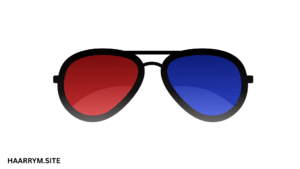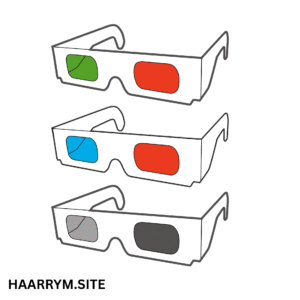Millions of people across the globe are drawn to amazing natural phenomena called solar eclipses. A magnificent celestial display results from the partial or total blocking of sunlight by the Moon between the Earth and the Sun. Although solar eclipses are attractive, if seen without appropriate eye protection can seriously compromise your eyesight.
Should you want to see an approaching solar eclipse, you may be wondering: are 3D glasses available for solar eclipse viewing?
No is the quick and basic response. 3D glasses are not safe for viewing directly the Sun during an eclipse—or at any other time.
We will discuss in this blog article the reasons 3D glasses are unsuitable for eclipse watching, what distinguishes solar eclipse glasses, and how to responsibly enjoy this uncommon event without compromising your vision.
Why You Should Not View a Solar Eclipse Through 3D Glasses
Designed for a somewhat different function than eclipse watching, 3D glasses—like those used in movie theaters or with 3D TVs—are usually with red-blue (anaglyph) or polarized lenses. These glasses provide the impression of three-dimensional depth while viewing especially designed pictures. Their intended use is not to filter strong sunlight.
Main Reasons 3D Glasses Are Not Safe for Solar Viewing:
Poor Light Filtering
3D glasses’ lenses are not quite black enough to screen the strong Sun’s rays. The visible and invisible radiation may irreversibly damage your retina in seconds even during a partial solar eclipse.
3D glasses neither shield your eyes from UV or IR radiation, both of which might damage them during a solar eclipse.
False Sense of Safety
3D glasses may give you the impression of protection as they limit the light and lower glare. This false sensation of protection might cause one to stare longer at the Sun, therefore increasing their chance of major eye damage.
What Happens If You See a Solar Eclipse Without Appropriate Glasses?
Solar retinopathy is a disorder brought on by seeing the Sun unprotected eyes-wise. This occurs because strong sun radiation actually burning the light-sensitive tissue at the rear of your eye, the retina. One may have solar retinopathy and:
-
foggy eyes
-
hidden areas
-
slanted vision
-
permanent eyesight loss
Sadly, there is no medical intervention available to undo the harm done by Sun gazing.
Your eyes still run just as much risk even if the Sun is partly hidden during a solar eclipse. Only if you are in the line of totality will it be safe for you to see the Sun with your naked eye—during the short totality period of a complete solar eclipse.
For a Solar Eclipse, What Type of Glasses Should You Wear?
ISO 12312-2 approved solar eclipse glasses are required for safe viewing of a solar eclipse. These lenses are made especially to shield your eyes from damaging solar radiation and lower sunlight to a safe level.
Safe Solar Eclipse Glasses’ Characteristics:
-
ISO certifications: Search for the ISO 12312-2 label. This worldwide safety criteria guarantees the glasses satisfy all the protection criteria.
-
Extremely dark lenses block 99.999% of the sunlight.
-
UV and IR Protection: They protect your eyes from infrared and UV radiation capable of retinal damage.
-
Check for damage before use—including scratches, tears, or other defects.
Never use homemade filters, welding goggles (unless they are shade 14 or darker), or sunglasses. These do not completely guard against UV and IR radiation, however they filter visible light.
How to Select Safe Eclipse Glasses
Many fake or inferior eclipse glasses have entered the market as knowledge about solar eclipse safety rises. These pointers help you ensure you’re getting the genuine deal:
-
Purchase from reliable sources; search for eclipse glasses from reputable companies or stores advised by NASA or the American Astronomical Society (AAS).
-
Check the Certification: Clearly mention in the box or the glasses themselves whether they satisfy the ISO 12312-2 criteria.
-
Before usage, hold the glasses up to a strong light—but not the Sun—such that you cannot see anything save the brightest lights.
Are There Any Do-It-Your-Own Alternatives to Eclipse Glasses?
Although approved eclipse glasses are the best for safety, there are various indirect viewing techniques that let one safely experience the eclipse:
-
Making a tiny hole in a sheet of paper, project the Sun’s image onto a level surface.
-
Under a leafy tree, stand during the eclipse and see the ground create crescent-shaped shadows.
-
If you use binoculars or a telescope, be sure their front end has a suitable sun filter. Never stare straight at the Sun via unvarnished optics.
These techniques are totally safe when applied properly and do not call for you to see the Sun directly.
Often Held Stories Regarding Eclipse Viewing
Let’s refute some harmful false ideas:
-
Myth: 3D movie glasses dark enough for this purpose.
Actually, they won’t shield your eyes and are not meant to deflect sun rays. -
Myth: Good regular sunglasses are OK.
Actually, even the darkest shades allow in hundreds of times too much sunshine. -
Myth: Looking is safe because the sky seem foggy.
Realistically, UV rays may get through clouds. You still could harm your eyes. -
Myth: A cursory look won’t damage anything.
Actually, retinal damage may happen in a few seconds. Don’t gamble.
Finally, Give Your Eye Safety First Priority
Therefore, the loud negative is the response to the first question, can you wear 3D glasses for solar eclipse? Although it might be tempting to use what you have at home, incorrect protection is not worth the lasting harm you could do to your eyes.
Get some ISO-certified eclipse glasses or use safe indirect techniques like pinhole projection. The next time the Moon crosses the Sun, you will be able to savor the spectacle with total peace of mind—and with your eyesight intact.

Frequent Questions
Is it ever safe to witness solar events with 3D movie glasses?
A: Not exactly. Made for low indoor light, they provide little protection against dangerous sun radiation.
ISO 12312-2 denotes what?
A: It’s the worldwide safety guideline for sun viewing glasses. Standard glasses have shown to block UV, IR, and strong visible light coming from the Sun.
Can I take a selfie or see a solar eclipse with my phone camera?
A: The Sun’s rays may damage the camera of your phone even if it would appear safer; it may also reflect damaging light into your eyes.
Stay safe, knowledgeable, and enjoy the wonder of a solar eclipse the proper way.
Should this blog prove useful, please forward it to friends and relatives scheduled to see the next eclipse. Making a little effort now will pay off lifetime wise protection of your eyes.
